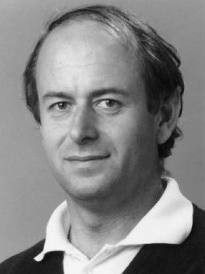David Olive facts for kids
Quick facts for kids
David Olive
|
|
|---|---|
 |
|
| Born |
David Ian Olive
16 April 1937 Middlesex, England
|
| Died | 7 November 2012 (aged 75) Cambridge, England
|
| Nationality | British |
| Alma mater |
|
| Known for |
|
| Spouse(s) |
Jenny Olive
(m. 1963) |
| Awards | Dirac Medal |
| Scientific career | |
| Fields | Theoretical physics |
| Institutions | University of Cambridge Carnegie Institute of Technology CERN Imperial College London University of Swansea |
| Thesis | Unitarity and S-matrix theory (1963) |
| Doctoral advisor | John Clayton Taylor |
| Doctoral students | Neil Turok Ed Corrigan Andrew Crumey |
David Ian Olive CBE FRS FLSW (born April 16, 1937 – died November 7, 2012) was a very important British scientist. He was a theoretical physicist who studied how the universe works at its most basic level. He made big discoveries in string theory and duality theory. These ideas help us understand tiny particles and forces. He is especially known for his work on the GSO projection and Montonen–Olive duality.
He taught physics at Imperial College London and later helped start a new physics group at Swansea University. He won the Dirac Prize and Medal in 1997 for his amazing work. He was also a member of the Royal Society, which is a group of top scientists.
Contents
About David Olive
His Early Life and Learning
David Olive was born in Middlesex, England, in 1937. He went to school in Edinburgh, Scotland, at the Royal High School and then Edinburgh University. Later, he moved to St John's College, Cambridge and earned his PhD in 1963. His main teacher there was John Taylor.
His Scientific Career and Discoveries
After finishing his studies, David Olive worked for a short time at the Carnegie Institute in Pittsburgh. Then, he returned to Cambridge and became a lecturer in 1965. Here, he helped develop a way to understand particle physics called S-matrix theory. His book, The Analytic S-matrix, written with other scientists, is still an important guide on the topic.
In 1971, Olive made a big decision to move to CERN, a famous science center in Switzerland. He joined a team working on what was then called the "dual resonance model." This model soon became known as string theory. At CERN, Olive worked with other string theorists. He helped create the GSO projection, which was a key step in developing 10-dimensional superstring theory. This idea helped explain how supersymmetry makes string theory work.
Olive was one of the first scientists to believe that string theory could be a single, unified theory for all particle interactions. This includes gravity, which is the force that pulls things down. He talked about this exciting idea at a big conference in London in 1974.
In 1977, Olive came back to the UK. He became a professor at Imperial College London in 1984. There, he worked with Peter Goddard on the mathematical rules of string theory. Their work helped identify special groups in mathematics, which later showed why string theory was so important.
Their work from 1973 to 1983 was recognized with the prestigious Dirac Medal in 1997. They received the award for their "far-sighted and highly influential contributions to theoretical physics." This means their ideas greatly shaped our understanding of string theory and other physics theories.
The Dirac Medal also recognized Olive's work on duality in gauge field theories. While at CERN, Olive studied magnetic monopoles. These are like single poles of a magnet, unlike regular magnets that always have two poles. In 1977, with Claus Montonen, he suggested that there might be a "dual" theory where magnetic monopoles and other particles switch roles. This idea, called Montonen–Olive duality, later became a key part of M-theory. M-theory is a bigger theory that connects different string theories.
In 1992, Olive moved to Swansea University. There, he helped build a new group for theoretical particle physics. He continued to study the deep symmetries in quantum field theories. A conference was held in his honor in Swansea in 2004 to celebrate his retirement.
See also
- GSO projection
- Montonen–Olive duality
- M-theory
- Supersymmetry
- String theory

